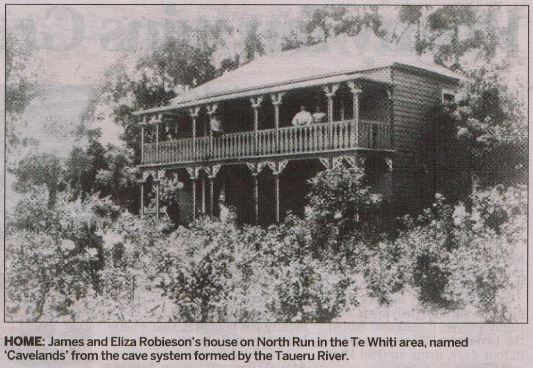 High on the hills of Mount Victoria in Wellington, with panoramic views of the city,
there wends a street named after a forgotten war hero from Wairarapa. On Tuesday
members of his family joined councillors and staff from Wellington City Council
gather to mark the centenary of the death of Norman Robieson. Gareth Winter from
the Wairarapa Archive looks at this story.
High on the hills of Mount Victoria in Wellington, with panoramic views of the city,
there wends a street named after a forgotten war hero from Wairarapa. On Tuesday
members of his family joined councillors and staff from Wellington City Council
gather to mark the centenary of the death of Norman Robieson. Gareth Winter from
the Wairarapa Archive looks at this story.
The bloodlines of two of the most influential families in early Wairarapa came
together in the children of James Robieson and his wife Eliza Renall.
Robieson came to New Zealand as a 12-year-old with his sister Jean, Charles Rooking
Carter's wife. He stayed in Wellington where Carter was a successful businessman
and eventually came across to Wairarapa, managing Carter's extensive North Run
pastoral holdings on the Taratahi Plain.
In 1863, then aged 24, Robieson married Elizabeth Percy Renall, the daughter of the
charismatic miller and politician Alfred Renall and his second wife Eliza Percy.
Renall and Carter had both been important driving forces in the establishment of
the Small Farms Association that led to the closer settlement of the Wairarapa
valley, and Eliza's family were to also venture into Wairarapa, where they were
successful farmers.
In time, James and Eliza were able to purchase a parcel of North Run in the Te
Whiti area from Carter, naming it Cavelands from the cave system formed by the
Taueru River. By 1876 the family were farming 576 acres on which they erected an
imposing two-storey homestead where they raised their 14 children.
The youngest of these children was Norman Athelstan, born at Cavelands in 1884. He
was educated at the local Te Whiti School, alongside his siblings, and a large
number of Renall cousins, his uncle Joseph Renall, a future mayor of Masterton,
also farming in the area.
He stayed at Te Whiti School until he was 15, and then shifted to Wellington, where
he found work with the Wellington City Council.
He continued his studies in Wellington - in 1903 he was studying at the Wellington
Technical School, earning a first place prize for book-keeping. Later, he
studied at Victoria University, and became a member of the Victoria College
Officers Training Corps, excelling at target shooting. He was also very
interested in other sports, notably tennis, yachting and golf.
He tried to enlist almost as soon as war was declared, having his medical on August
18, 1914, then entered Trentham Camp in October and joined the Wellington
Mounted Rifles. Despite being so sporty, he was a small man - his medical
examination papers disclose that he weighed 57kg on enlistment. He was promoted
to corporal a few days after his arrival, although he was demoted to
lance-corporal once he arrived overseas.
He left New Zealand in the middle of December 1914, destined for Egypt, where he
underwent further training before heading to the Dardanelles in May 1914,
shortly after the landing at Anzac Cove.
Unfortunately, his army records are scant for his period of service on the Gallipoli Peninsula.
He was severely injured, with gunshot wounds to the skull and forearm. According
to newspaper reports, he was wounded by shrapnel shot shortly after reaching the
firing line. In August he was placed on the hospital ship HMS Asturias, bound
for England where his wounds could be better treated, but on August 21, in the
Mediterranean between Malta and Gibraltar, he died.
He was buried at sea.
In a will made out the day before he left for camp, he divided his assets among his
siblings and their spouses.
His workmates did not forget him. In late July 1916, Wellington mayor JP Luke
unveiled an oil portrait of Norman Robieson in the club room of the Town Hall,
with staff and family representatives present.
The mayor paid tribute to Robieson, referring to his courage and "nobility in
laying down his life so that others may live". The following year the
council renamed Victoria Rd in Mount Victoria in his honour. His name is now
recorded on a large bronze plaque in the Wellington City Council atrium, along
with all the staff who served. After the war, his name was included among the
many recorded on the Lone Pine Memorial at Gallipoli.
Ironically, despite his strong Wairarapa links, he seems to have been forgotten in the
period after the war. His name does not appear on the Soldiers Memorial in Queen
Elizabeth Park but the Robieson family plot in the Masterton Cemetery contains a
small granite stone that marks his passing.